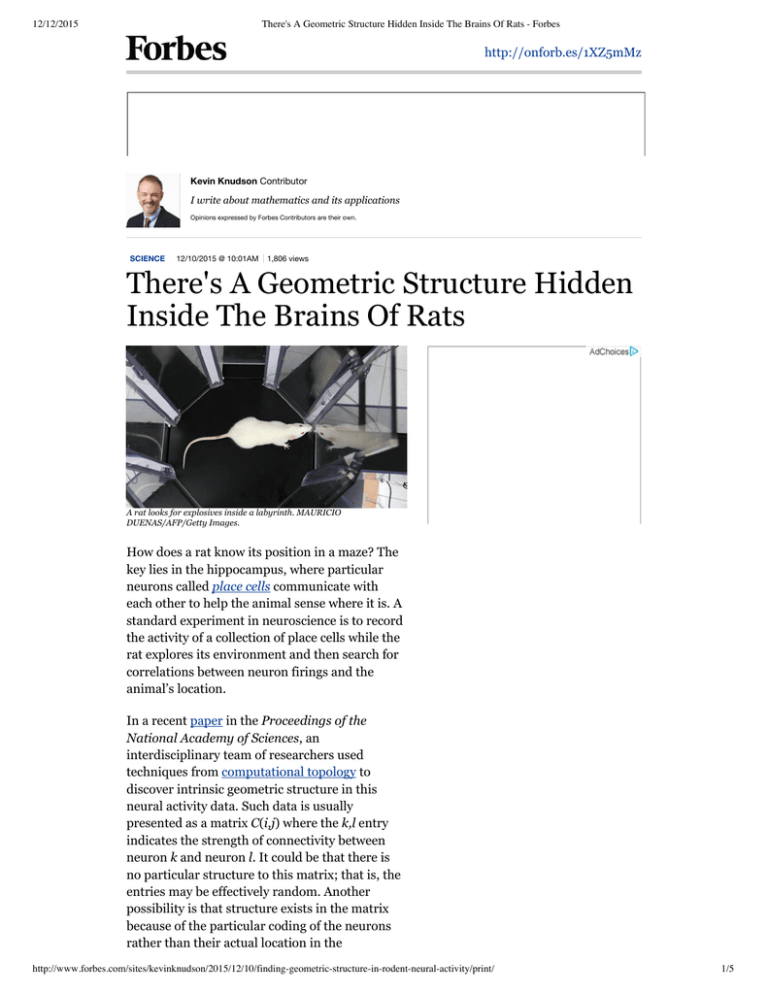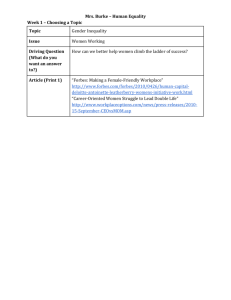
12/12/2015
There's A Geometric Structure Hidden Inside The Brains Of Rats - Forbes
http://onforb.es/1XZ5mMz
Kevin Knudson Contributor
I write about mathematics and its applications
Opinions expressed by Forbes Contributors are their own.
SCIENCE
12/10/2015 @ 10:01AM
1,806 views
There's A Geometric Structure Hidden
Inside The Brains Of Rats
A rat looks for explosives inside a labyrinth. MAURICIO
DUENAS/AFP/Getty Images.
How does a rat know its position in a maze? The
key lies in the hippocampus, where particular
neurons called place cells communicate with
each other to help the animal sense where it is. A
standard experiment in neuroscience is to record
the activity of a collection of place cells while the
rat explores its environment and then search for
correlations between neuron firings and the
animal’s location.
In a recent paper in the Proceedings of the
National Academy of Sciences, an
interdisciplinary team of researchers used
techniques from computational topology to
discover intrinsic geometric structure in this
neural activity data. Such data is usually
presented as a matrix C(i,j) where the k,l entry
indicates the strength of connectivity between
neuron k and neuron l. It could be that there is
no particular structure to this matrix; that is, the
entries may be effectively random. Another
possibility is that structure exists in the matrix
because of the particular coding of the neurons
rather than their actual location in the
http://www.forbes.com/sites/kevinknudson/2015/12/10/finding-geometric-structure-in-rodent-neural-activity/print/
1/5
12/12/2015
There's A Geometric Structure Hidden Inside The Brains Of Rats - Forbes
hippocampus. Place cells fire rapidly when the
rat is in their preferred region of the
environment, so it is desirable to have a method
to detect the geometric organization of the
network using only intrinsic properties of the
matrix C(i,j).
The new idea is to analyze the order complex of
the matrix using persistent homology. Say we are
dealing with an n × n matrix A(i,j). The order
complex is built by taking a vertex v(j) for j=1,…n
and then adding an edge from v(k) to v(l) in
decreasing order of the entries of the matrix; this
is really a nested sequence of graphs. Since the
neural data matrix is symmetric (the i,j entry
equals the j,i entry), we consider matrices of this
type only. Here is a simple example in the case
n=3.
A clique in a graph is a subgraph where each
vertex is connected to all the others. The triangle
above has several cliques: the triangle itself and
each edge. If we have a clique, we can imagine
filling it in, and then collections of cliques might
bound something that can’t be filled in. For
example, if four vertices form a square (in which
the diagonal vertices are not connected), then
each edge is a clique and the four cliques gang up
to make a loop that isn’t filled in (we call this a 1­
cycle). Or, say we had a tetrahedron consisting of
four triangular faces. Then each of the triangles is
a clique and the four of them bound a 3dimensional void that isn’t filled in (we then call
the tetrahedron a 2­cycle). Homology is the
algebraic mechanism to encode all the cycles in a
complex, and it can be computed via standard
linear algebra. The kth Betti number is the count
of the number of independent k-cycles.
Now here’s the idea. Take a symmetric matrix
and look at its order complex. There will be many
cliques, but we want to look at them in a clever
way. As we build the order complex by adding
edges, we can think of this as a corresponding
adjacency matrix–the i,j and j,i entries are 1 if the
edge exists in the order complex and 0 otherwise.
We may then measure the density ρ
= k/[n(n+1)/2] of nonzero entries in the
http://www.forbes.com/sites/kevinknudson/2015/12/10/finding-geometric-structure-in-rodent-neural-activity/print/
2/5
12/12/2015
There's A Geometric Structure Hidden Inside The Brains Of Rats - Forbes
adjacency matrix (k is the number of edges in
the kth stage of the order complex) and watch
how cliques evolve as we increase ρ from 0
upwards. In the picture above, the densities are
0, 1/3, 2/3, and 1, respectively. Cliques may form
cycles of various dimensions at one value of ρ but
then these cycles may get filled in at higher
density values as more edges (and therefore more
triangles, solid tetrahedra, etc.) appear. Keeping
count of these as ρ increases measures the
persistent homology of the order complex
(cycles persist for a range of density values,
hence the name) and we may graph the Betti
numbers against density.
Suppose we take a random symmetric matrix.
What should we expect these curves of Betti
numbers to look like? The authors ran
experiments and discovered that the graphs look
like this:
Betti number curves for random matrices, image excerpted from
original paper.
On the other hand, for matrices built from
pairwise distances in space (a so-called
geometric matrix), the Betti curves look like:
Betti curves associated to geometric data, image excerpted from original
paper.
There are clear differences in these signatures,
suggesting that this technique is able to
differentiate random data from geometric.
Returning to the rodent neural activity data,
http://www.forbes.com/sites/kevinknudson/2015/12/10/finding-geometric-structure-in-rodent-neural-activity/print/
3/5
12/12/2015
There's A Geometric Structure Hidden Inside The Brains Of Rats - Forbes
where the rat is exploring its 2-dimensional
environment, the analysis gives this Betti
number profile:
Betti numbers associated to neural activity, image excerpted from
original paper.
Clearly, this resembles the profile associated to
geometric data rather than random data. This is
the first time geometric structure has been found
intrinsically in neural data. Certainly such a
structure is to be expected since the rat’s place
cells keep track of the geometry of the
environment, but this result is confirmation that
it can be detected using only the pattern of
correlations among the neurons. And it suggests
that such geometric structure is a property of the
underlying place cell network and not a result of
the spatial structure of the input cells.
In the end, there is still a great deal that we do
not know about the structure of rat brains, never
mind those of humans, but any new technique to
understand how they work is welcome. We can
add the study of clique topology to the toolbox.
RECOMMENDED BY FORBES
Everything You Ever Wanted To Know About Pi,
Part 3: The Area Of A Circle
Mathematics For Optimal Wing Design
The World's Highest-Paid Musicians of 2015
Astronomers Find New Object, Possible SuperEarth In Our Solar System
http://www.forbes.com/sites/kevinknudson/2015/12/10/finding-geometric-structure-in-rodent-neural-activity/print/
4/5
12/12/2015
There's A Geometric Structure Hidden Inside The Brains Of Rats - Forbes
This article is available online at: http://onforb.es/1XZ5mMz
2015 Forbes.com LLC™ All Rights Reserved
http://www.forbes.com/sites/kevinknudson/2015/12/10/finding-geometric-structure-in-rodent-neural-activity/print/
5/5



